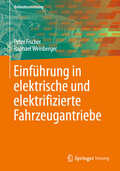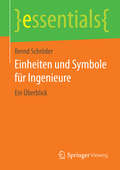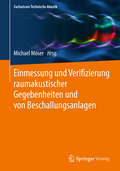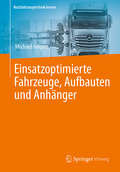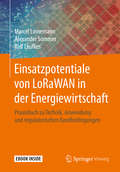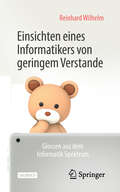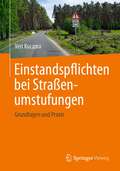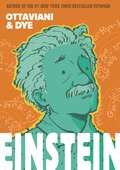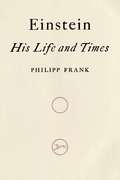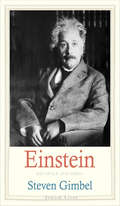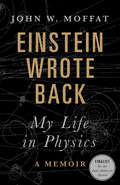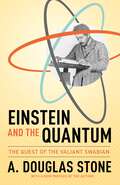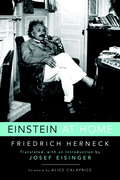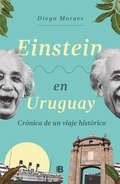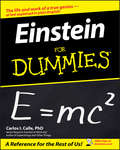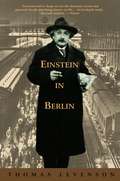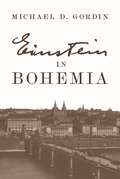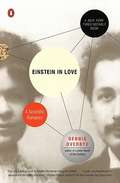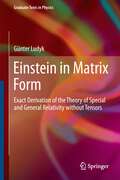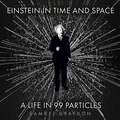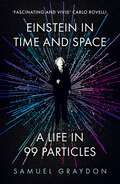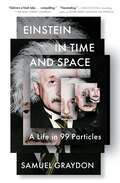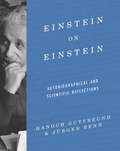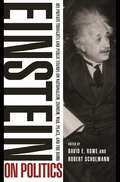- Table View
- List View
Einführung in elektrische und elektrifizierte Fahrzeugantriebe
by Peter Fischer Raphael WeinbergerDieses Buch bietet eine kompakten Überblick zu Systemarchitekturen, Komponenten und Funktionsweisen von elektrischen Fahrzeugantrieben. Zielgruppe sind Techniker:innen mit bestehenden Erfahrungen zu konventionell angetrieben Fahrzeugen, welche sich im Gebiet der elektrischen und elektrifizierten Antrieben einen Überblick verschaffen wollen. Das Buch vermittelt Systemverständnis für Elektrofahrzeuge, deren Einbettung in Infrastruktur und Wandel der Technologien. Daraus wird die Funktionsweise der Komponenten elektrischer und elektrifizierter Antriebe abgeleitet und deren wesentliche technische Herausforderungen aufgezeigt. Das Buch ist ein Nachschlagwerk für typische Kennwerte elektrischer Antriebe und deren Komponenten, es zeigt wesentliche beispielhaften Ausführungen und bietet Ansätze für weitere Vertiefungen in das Thema.
Einheiten und Symbole für Ingenieure: Ein Überblick (essentials)
by Bernd SchröderTechnische Kommunikation ist auf einvernehmliche Bedeutung von Einheiten angewiesen. Hierfür bietet das Système International (SI) eine weitgehend anerkannte Basis, die hier vorgestellt wird. Die entsprechenden Größen und Einheiten sind aufgelistet und abgeleitete Werte nach Themengebieten zusammengefasst. Auch Größen und Einheiten außerhalb von SI sind aufgeführt. Ergänzend werden kurz die römischen Zahlen und griechischen Buchstaben vorgestellt.
Einmessung und Verifizierung raumakustischer Gegebenheiten und von Beschallungsanlagen (Fachwissen Technische Akustik)
by Michael MöserIn diesem Band der Reihe Fachwissen Technische Akustik werden einleitend die möglichen Messverfahren beschrieben. Dabei stehen Schalldruckmessungen und Schallpegelmessungen sowie deren Bewertung und Verfahren mittels Fourieranalyse im Mittelpunkt. Es werden die klassische Anregung mit Rauschen, das Sweep-Verfahren, die MLS-Technik, die Noise-Applikation, die TDS-Technik und das quellensignalunabhängige Messverfahren mit Echtzeitentfaltung erläutert. Anschließend wird näher auf die vorhandenen Messparameter eingegangen. Dieser Abschnitt befasst sich mit Absolut- und Relativmessungen, Eichung, Messfehlern und –optimierung, dem Messsystem und der Messkette, äußeren Einflüssen und dem Postprozessing. Bei den raumakustischen Messungen wird auf die Festlegung der Messsorte sowie auf den üblichen Messaufbau eingegangen. Es werden Zeitgrößen, Frequenzgrößen, Wasserfalldarstellung und spezielle Anwendungen wie Insitu-Messungen und die Messung der Scattering-Koeffizienten erläutert. Die Messungen in der Beschallungstechnik beginnen mit einer subjektiven Bewertung der vorhandenen Beschallungsqualität. Störende Nebengeräusche werden festgestellt und durch elektrisches Einmessen beseitigt. Zum akustischen Einmessen gehört u.a. die Ermittlung der Schallpegelverteilung, die Messung des Wiedergabefrequenzganges, die Erläuterung der Messverfahren wie Überprüfung der Kohärenz der eintreffenden Wellenfronten, die objektive Ermittlung der Verständlichkeit, die Schallpegelmessung, die Schallpegelverteilung sowie spezielle Messungen. Im Anhang sind Messverfahren auf Hardware- und Softwarebasis zusammengestellt.
Einsatzoptimierte Fahrzeuge, Aufbauten und Anhänger
by Michael HilgersDie komplexe Nutzfahrzeugtechnik anschaulich darzustellen ist Ziel dieses Werkes, das aus 9 einzelnen, in sich abgeschlossenen Beiträgen besteht. Kompakt und gut verständlich bietet es den Überblick heutiger Technik im Nutzfahrzeug. Ausgehend von den grundlegenden Anforderungen des Kunden werden die konzeptionsbestimmenden Charakteristika und Systeme in geschlossenen Beiträgen fundiert dargestellt. Dieser Band behandelt die Aufbauten und Anhänger, die ein Nutzfahrzeug für den jeweiligen Einsatz optimal ergänzen. Aufbauten, Anhänger und spezifische Ausstattungen werden erklärt. Für den Leser in Ausbildung und Praxis wird ein guter Überblick gegeben.
Einsatzpotentiale von LoRaWAN in der Energiewirtschaft: Praxisbuch zu Technik, Anwendung und regulatorischen Randbedingungen
by Marcel Linnemann Alexander Sommer Ralf LeufkesLoRAWAN stellte eine kostengünstige Technologie dar, mit der Prozesse innerhalb einer Stadt schnell und einfach vernetzt werden können. Für die Versorgungswirtschaft ergeben sich hieraus enorme potentiale und Geschäftsmodelle. Dieses Buch beschreibt die Technik, die Einsatzfelder, die Potentiale und die regulatorischen Anforderungen, die berücksichtigt werden müssen.
Einsichten eines Informatikers von geringem Verstande: Glossen aus dem Informatik Spektrum
by Reinhard WilhelmEs ist für Fachleute wie Laien immer wieder überraschend, wie die Errungenschaften der Informatik das Leben der Menschen verbessern können, manchmal sogar in Richtungen, welche die Menschen gar nicht unbedingt wünschen. Die aus der Zeitschrift Informatik Spektrum stammenden Glossen in diesem Buch beschreiben kurzweilig und mit viel Humor viele solcher Errungenschaften: Wie sie entstehen, weshalb sie vielleicht doch nicht so groß sind und was noch auf uns zukommt.Eine amüsante Lektüre für Informatiker und ihre gequälten Anwender.
Einstandspflichten bei Straßenumstufungen: Grundlagen und Praxis
by Veit KuczoraDer Lebenszyklus einer Straße besteht aus Planen, Bauen und Betreiben. Die zu beachtenden Vorgaben und Rahmenbedingungen reichen über unterschiedlichste Fachgebiete und erfordern die Zusammenarbeit verschiedenster Spezialisten und Generalisten. Jede Straße stellt aufgrund ihrer raumordnerischen Funktion, ihrer bautechnischen Einordnung in der Landschaft und ihrer verkehrstechnischen und –rechtlichen Ausstattung ein Unikat dar. Eine Besonderheit im Lebenszyklus einer Straße ist der Wechsel der Baulastträgerschaft. Unter welchen Voraussetzungen und Rechtsanwendungen eine Umstufung von Straßen erfolgt, ist maßgeblich von straßenrechtlichen und raumordnerischen Belangen abhängig und nicht Gegenstand des vorliegenden Buches. Als rechtliche Voraussetzung für die Betrachtungen innerhalb des Buches wird eine rechtskräftige Umstufung angenommen. Es sollen somit die Fragen, die bei der Abwicklung der Rechtsfolgen einer Umstufung in Form der Einstandspflicht auftreten, beantwortet werden. Dabei steht die Verzahnung von straßenrechtlichen, bautechnischen und verwaltungstechnischen Aspekten im Vordergrund. Zielgruppen des Buches sind daher Studenten in bau- und verwaltungstechnischen Studiengängen sowie Ingenieure und Entscheidungsträger in Verwaltungen und Ingenieurbüros.
Einstein
by Jim OttavianiIn Einstein, writer Jim Ottaviani and artist Jerel Dye take us behind the veneer of Einstein’s celebrity, painting a complex and intimate portrait of the world’s most well-known scientist.E = mc² A world-changing equation and a wild head of hair are all most of us know about one of history’s greatest minds, despite his being a household name in his lifetime and an icon in ours. But while the broad outlines of what Einstein did are well known, who he was remained hidden from view to most...even his closest friends. This is the story of a scientist who made many mistakes, and even when he wanted to be proven wrong, was often right in the end. It's a story of a humanist who struggled to connect with people. And it's a story of a reluctant revolutionary who paid a high price for living with a single dream. In Einstein, Jim Ottaviani and Jerel Dye take us behind the veneer of celebrity, painting a complex and intimate portrait of the scientist whose name has become another word for genius.
Einstein
by Philipp FrankMuch has been written about Albert Einstein, technical and biographical, but very little remains as valuable as this unique hybrid of a book written by Einstein’s colleague and contemporary. Both rich in personal insights and grounded in a deep knowledge of twentieth-century science, Phillip Frank's biography anchors the reader with a lucid overview of physics and draws an intimate portrait of the Nobel Prize-winner.
Einstein
by Steven GimbelIs relativity Jewish? The Nazis denigrated Albert Einstein's revolutionary theory by calling it "Jewish science," a charge typical of the ideological excesses of Hitler and his followers. Philosopher of science Steven Gimbel explores the many meanings of this provocative phrase and considers whether there is any sense in which Einstein's theory of relativity is Jewish. Arguing that we must take seriously the possibility that the Nazis were in some sense correct, Gimbel examines Einstein and his work to explore how beliefs, background, and environment may-or may not-influence the work of the scientist. You cannot understand Einstein's science, Gimbel declares, without knowing the history, religion, and philosophy that influenced it. No one, especially Einstein himself, denies Einstein's Jewish heritage, but many are uncomfortable saying that he was a Jew while he was at his desk working. To understand what "Jewish" means for Einstein's work, Gimbel first explores the many definitions of "Jewish" and asks whether there are elements of Talmudic thinking apparent in Einstein's theory of relativity. He applies this line of inquiry to other scientists, including Isaac Newton, René Descartes, Sigmund Freud, and Émile Durkheim, to consider whether and how their specific religious beliefs or backgrounds manifested in their scientific endeavors. Einstein's Jewish Science intertwines science, history, philosophy, theology, and politics in fresh and fascinating ways to solve the multifaceted riddle of what religion means-and what it means to science. There are some senses, Gimbel claims, in which Jews can find a special connection to E = mc2, and this claim leads to the engaging, spirited debate at the heart of this book.
Einstein Wrote Back: My Life in Physics
by John W. MoffatJohn W. Moffat was a poor student of math and science. That is, until he read Einstein’s famous paper on general relativity. Realizing instantly that he had an unusual and unexplained aptitude for understanding the complex physics described in the paper, Moffat wrote a letter to Einstein that would change the course of his life. Einstein Wrote Back tells the story of Moffat’s unusual entry into the world of academia and documents his career at the frontlines of twentieth-century physics as he worked and associated with some of the greatest minds in scientific history, including Niels Bohr, Fred Hoyle, Wolfgang Pauli, Paul Dirac, Erwin Schrödinger, J. Robert Oppenheimer, Abdus Salam, among others. Taking readers inside the classrooms and minds of these giants of modern science, Moffat affectionately exposes the foibles and eccentricities of these great men, as they worked on the revolutionary ideas that, today, are the very foundation of modern physics and cosmology.
Einstein and the Quantum: The Quest of the Valiant Swabian
by A. Douglas StoneThe untold story of Albert Einstein's role as the father of quantum theoryEinstein and the Quantum reveals for the first time the full significance of Albert Einstein's contributions to quantum theory. Einstein famously rejected quantum mechanics, observing that God does not play dice. But, in fact, he thought more about the nature of atoms, molecules, and the emission and absorption of light—the core of what we now know as quantum theory—than he did about relativity.A compelling blend of physics, biography, and the history of science, Einstein and the Quantum shares the untold story of how Einstein—not Max Planck or Niels Bohr—was the driving force behind early quantum theory. It paints a vivid portrait of the iconic physicist as he grappled with the apparently contradictory nature of the atomic world, in which its invisible constituents defy the categories of classical physics, behaving simultaneously as both particle and wave. And it demonstrates how Einstein's later work on the emission and absorption of light, and on atomic gases, led directly to Erwin Schrödinger's breakthrough to the modern form of quantum mechanics. The book sheds light on why Einstein ultimately renounced his own brilliant work on quantum theory, due to his deep belief in science as something objective and eternal.
Einstein at Home
by Alice Calaprice Josef Eisinger Friedrich HerneckThese intimate, candid descriptions of the private life of Albert Einstein come from a series of interviews with Herta Waldow, a housekeeper who lived with Einstein and his wife and daughter from 1927 to 1933 at their residence in Berlin. After World War II, science historian Friedrich Herneck interviewed Ms. Waldow and published the conversations in the former East Germany. Unavailable in English till now, these five interviews offer fascinating glimpses into the great scientist's daily routines while he lived as a celebrated scientist in Weimar Germany.Einstein's well-known idiosyncrasies come to life in these conversations: his disheveled hair that was only poorly trimmed by his myopic wife, his love of classical music, his playing of the violin to help him think, his delight in sailing, his wide circle of friends and many social engagements, and his female companions besides his wife. Many celebrity acquaintances are also mentioned: from movie star Charlie Chaplin and conductor Erich Kleiber to writers Thomas and Heinrich Mann and fellow scientists Max Planck, Max Born, and Erwin Schrödinger.With a detailed introduction that puts these interviews in context, these colorful conversations create a vivid picture of Albert Einstein the man.From the Trade Paperback edition.
Einstein en Uruguay: Crónica de un viaje histórico
by Diego MoraesUn exhaustivo trabajo de investigación en el que Diego Moraes reconstruye el viaje de uno de los personajes más importantes en la historia de la humanidad y un Uruguay a la vanguardia de la cultura y el pensamiento. En 1925 el famoso físico alemán Albert Einstein realizó una histórica visita al Uruguay. Casi cien años han pasado desde entonces pero, en la actualidad, ¿qué sabemos los uruguayos sobre aquel episodio? Una estatua ubicada en la Plaza de los Treinta y Tres, en el Centro montevideano, recuerda el momento más famoso de aquella visita: el célebre encuentro mantenido en ese mismo sitio entre Einstein y el filósofo Carlos Vaz Ferreira. Sin embargo, es poco más lo que se conoce, en términos generales. ¿Qué vino a hacer Einstein al Uruguay? ¿Quién lo invitó a nuestro país y por qué? ¿Qué personajes prominentes de la sociedad uruguaya conoció durante su estadía? ¿Dónde se alojó? ¿Qué actividades realizó durante la semana que permaneció en suelo uruguayo? ¿Qué impresión dejó entre los compatriotas de 1925? E, inversa mente, ¿qué opinión guardó luego de su paso por estas tierras? Estas son solo algunas de las preguntas que este libro aspira a responder.
Einstein for Dummies
by Carlos I. CalleGenius demystified, the Dummies way! In 1905, Albert Einstein revolutionized modern physics with his theory of relativity. He went on to become a twentieth-century icon-a man whose name and face are synonymous with "genius." Now, at last, ordinary readers can explore Einstein's life and work in this new For Dummies guide. Physicist Carlos Calle chronicles Einstein's career and explains his work-including the theories of special and general relativity-in language that anyone can understand. He shows how Einstein's discoveries affected everything from the development of the atom bomb to the theory of quantum mechanics. He sheds light on Einstein's personal life and beliefs, including his views on religion and politics. And he shows how Einstein's work continues to affect our world. today, from nuclear power to space travel to artificial intelligence.
Einstein in 90 Minutes
by John Gribbin Mary GribbinBrief biography and description of Einstein's contributions.
Einstein in Berlin
by Thomas LevensonIn a book that is both biography and the most exciting form of history, here are eighteen years in the life of a man, Albert Einstein, and a city, Berlin, that were in many ways the defining years of the twentieth century. Einstein in BerlinIn the spring of 1913 two of the giants of modern science traveled to Zurich. Their mission: to offer the most prestigious position in the very center of European scientific life to a man who had just six years before been a mere patent clerk. Albert Einstein accepted, arriving in Berlin in March 1914 to take up his new post. In December 1932 he left Berlin forever. “Take a good look,” he said to his wife as they walked away from their house. “You will never see it again.”In between, Einstein’s Berlin years capture in microcosm the odyssey of the twentieth century. It is a century that opens with extravagant hopes--and climaxes in unparalleled calamity. These are tumultuous times, seen through the life of one man who is at once witness to and architect of his day--and ours. He is present at the events that will shape the journey from the commencement of the Great War to the rumblings of the next one. We begin with the eminent scientist, already widely recognized for his special theory of relativity. His personal life is in turmoil, with his marriage collapsing, an affair under way. Within two years of his arrival in Berlin he makes one of the landmark discoveries of all time: a new theory of gravity--and before long is transformed into the first international pop star of science. He flourishes during a war he hates, and serves as an instrument of reconciliation in the early months of the peace; he becomes first a symbol of the hope of reason, then a focus for the rage and madness of the right. And throughout these years Berlin is an equal character, with its astonishing eruption of revolutionary pathways in art and architecture, in music, theater, and literature. Its wild street life and sexual excesses are notorious. But with the debacle of the depression and Hitler’s growing power, Berlin will be transformed, until by the end of 1932 it is no longer a safe home for Einstein. Once a hero, now vilified not only as the perpetrator of “Jewish physics” but as the preeminent symbol of all that the Nazis loathe, he knows it is time to leave.
Einstein in Bohemia
by Professor Michael D. GordinA finely drawn portrait of Einstein's sixteen months in PragueIn the spring of 1911, Albert Einstein moved with his wife and two sons to Prague, the capital of Bohemia, where he accepted a post as a professor of theoretical physics. Though he intended to make Prague his home, he lived there for just sixteen months, an interlude that his biographies typically dismiss as a brief and inconsequential episode. Einstein in Bohemia is a spellbinding portrait of the city that touched Einstein's life in unexpected ways—and of the gifted young scientist who left his mark on the science, literature, and politics of Prague.Michael Gordin's narrative is a masterfully crafted account of a person encountering a particular place at a specific moment in time. Despite being heir to almost a millennium of history, Einstein's Prague was a relatively marginal city within the sprawling Austro-Hungarian Empire. Yet Prague, its history, and its multifaceted culture changed the trajectories of Einstein's personal and scientific life. It was here that his marriage unraveled, where he first began thinking seriously about his Jewish identity, and where he embarked on the project of general relativity. Prague was also where he formed lasting friendships with novelist Max Brod, Zionist intellectual Hugo Bergmann, physicist Philipp Frank, and other important figures.Einstein in Bohemia sheds light on this transformative period of Einstein's life and career, and brings vividly to life a beguiling city in the last years of the Austro-Hungarian Empire.
Einstein in Love
by Dennis OverbyeIn Einstein in Love, Dennis Overbye has written the first profile of the great scientist to focus exclusively on his early adulthood, when his major discoveries were made. It reveals Einstein to be very much a young man of his time-draft dodger, self-styled bohemian, poet, violinist, and cocky, charismatic genius who left personal and professional chaos in his wake. Drawing upon hundreds of unpublished letters and a decade of research, Einstein in Love is a penetrating portrait of the modern era's most influential thinker.
Einstein in Matrix Form: Exact Derivation of the Theory of Special and General Relativity without Tensors
by Günter LudykThis book is an introduction to the theories of Special and General Relativity. The target audience are physicists, engineers and applied scientists who are looking for an understandable introduction to the topic - without too much new mathematics. The fundamental equations of Einstein's theory of Special and General Relativity are derived using matrix calculus, without the help of tensors. This feature makes the book special and a valuable tool for scientists and engineers with no experience in the field of tensor calculus. In part I the foundations of Special Relativity are developed, part II describes the structure and principle of General Relativity. Part III explains the Schwarzschild solution of spherical body gravity and examines the "Black Hole" phenomenon. Any necessary mathematical tools are user friendly provided, either directly in the text or in the appendices.
Einstein in Time and Space: A Life in 99 Particles
by Samuel GraydonA rollercoaster ride through the life and ideas of the twentieth century's most famous and controversial scientist in 99 sparkling vignettes.DROPOUT. PACIFIST. PHYSICIST. CASANOVA. REFUGEE. REBEL. GENIUS.THINK YOU KNOW EINSTEIN? THINK AGAINHis face is instantly recognisable. His name is shorthand for genius. Today, he's a figurehead as much as a man, symbolic of things larger than himself: of scientific progress, of the human mind, even of the age. But who was Einstein really?The Nobel Prize-winning physicist who discovered relativity, black holes and E = mc2, dined with Charlie Chaplin in Hollywood and was the inspiration for (highly radioactive) element 99, Albert Einstein was also a high school dropout with an FBI file 1,400 pages long.In this audiobook, Samuel Graydon's writing brings history's most famous scientist back to life. From his lost daughter to escaping the Nazis, from his love letters to unlikely inventions, from telling jokes to cheer up his sad parrot Bibo to refusing the Presidency of Israel, through the discoveries and thought experiments that changed science, Einstein in Time and Space tells 99 unforgettable stories of the man who redefined how we view our universe and our place within it.(P)2023 Hodder & Stoughton Limited
Einstein in Time and Space: A Life in 99 Particles
by Samuel GraydonDROPOUT. PACIFIST. PHYSICIST. CASANOVA. REFUGEE. REBEL. GENIUS.THINK YOU KNOW EINSTEIN? THINK AGAINHis face is instantly recognisable. His name is shorthand for genius. Today, he's a figurehead as much as a man, symbolic of things larger than himself: of scientific progress, of the human mind, even of the age. But who was Einstein really?The Nobel Prize-winning physicist who discovered relativity, black holes and E = mc2, dined with Charlie Chaplin in Hollywood and was the inspiration for (highly radioactive) element 99, Albert Einstein was also a high school dropout with an FBI file 1,400 pages long.In this book, Samuel Graydon brings history's most famous scientist back to life. From his lost daughter to escaping the Nazis, from his love letters to unlikely inventions, from telling jokes to cheer up his sad parrot Bibo to refusing the Presidency of Israel, through the discoveries and thought experiments that changed science, Einstein in Time and Space tells 99 unforgettable stories of the man who redefined how we view our universe and our place within it.
Einstein in Time and Space: A Life in 99 Particles
by Samuel GraydonWalter Isaacson&’s Einstein meets Craig Brown&’s 99 Glimpses of Princess Margaret, in this innovative biography of the famous physicist told in ninety-nine dazzling vignettes.Most of us would agree that Albert Einstein&’s name is synonymous with &“genius&” and that his likeness is often used as a shorthand for all scientists, appearing everywhere from cartoons to textbooks. He has become more myth than man. That being the case, how best to capture his essence? In Einstein in Time and Space, talented young science journalist Samuel Graydon answers that question with an illuminating mosaic—99 intriguingly different particles that cumulatively reveal Einstein&’s contradictory and multitudinous nature. Glimpsed among these shards: a slacker who failed every subject but math, a job seeker who couldn&’t get hired, a lothario who courted many women, and a charmer who was the life of the party. As brilliant as he was inconsistent, Einstein was simultaneously an avid supporter of the NAACP and the fight for civil rights and someone capable of great prejudice. He was loved by many, known by few, and inspirational to a generation of young physicists. Graydon reveals every corner of Einstein&’s world: the false reporting that rocketed Einstein to fame nearly overnight, his effect on people he met merely in passing, even the remarkable posthumous journey of the famed physicist&’s brain. Entertaining, comforting, bolstering, and shocking, Einstein in Time and Space is the unique story of a man who redefined how we view our universe and our place within it.
Einstein on Einstein: Autobiographical and Scientific Reflections
by Hanoch Gutfreund Jürgen RennNew perspectives on the iconic physicist's scientific and philosophical formationAt the end of World War II, Albert Einstein was invited to write his intellectual autobiography for the Library of Living Philosophers. The resulting book was his uniquely personal Autobiographical Notes, a classic work in the history of science that explains the development of his ideas with unmatched warmth and clarity. Hanoch Gutfreund and Jürgen Renn introduce Einstein's scientific reflections to today's readers, tracing his intellectual formation from childhood to old age and offering a compelling portrait of the making of a philosopher-scientist.Einstein on Einstein features the full English text of Autobiographical Notes along with incisive essays that place Einstein's reflections in the context of the different stages of his scientific life. Gutfreund and Renn draw on Einstein's writings, personal correspondence, and critical writings by Einstein's contemporaries to provide new perspectives on his greatest discoveries. Also included are Einstein's responses to his critics, which shed additional light on his scientific and philosophical worldview. Gutfreund and Renn quote extensively from Einstein's initial, unpublished attempts to formulate his response, and also look at another brief autobiographical text by Einstein, written a few weeks before his death, which is published here for the first time in English.Complete with evocative drawings by artist Laurent Taudin, Einstein on Einstein illuminates the iconic physicist's journey to general relativity while situating his revolutionary ideas alongside other astonishing scientific breakthroughs of the twentieth century.
Einstein on Politics: His Private Thoughts and Public Stands on Nationalism, Zionism, War, Peace, and the Bomb
by Albert EinsteinThe most famous scientist of the twentieth century, Albert Einstein was also one of the century's most outspoken political activists. Deeply engaged with the events of his tumultuous times, from the two world wars and the Holocaust, to the atomic bomb and the Cold War, to the effort to establish a Jewish homeland, Einstein was a remarkably prolific political writer, someone who took courageous and often unpopular stands against nationalism, militarism, anti-Semitism, racism, and McCarthyism. In Einstein on Politics, leading Einstein scholars David Rowe and Robert Schulmann gather Einstein's most important public and private political writings and put them into historical context. The book reveals a little-known Einstein--not the ineffectual and naïve idealist of popular imagination, but a principled, shrewd pragmatist whose stands on political issues reflected the depth of his humanity.Nothing encapsulates Einstein's profound involvement in twentieth-century politics like the atomic bomb. Here we read the former militant pacifist's 1939 letter to President Franklin D. Roosevelt warning that Germany might try to develop an atomic bomb. But the book also documents how Einstein tried to explain this action to Japanese pacifists after the United States used atomic weapons to destroy Hiroshima and Nagasaki, events that spurred Einstein to call for international control of nuclear technology.A vivid firsthand view of how one of the twentieth century's greatest minds responded to the greatest political challenges of his day, Einstein on Politics will forever change our picture of Einstein's public activism and private motivations.
